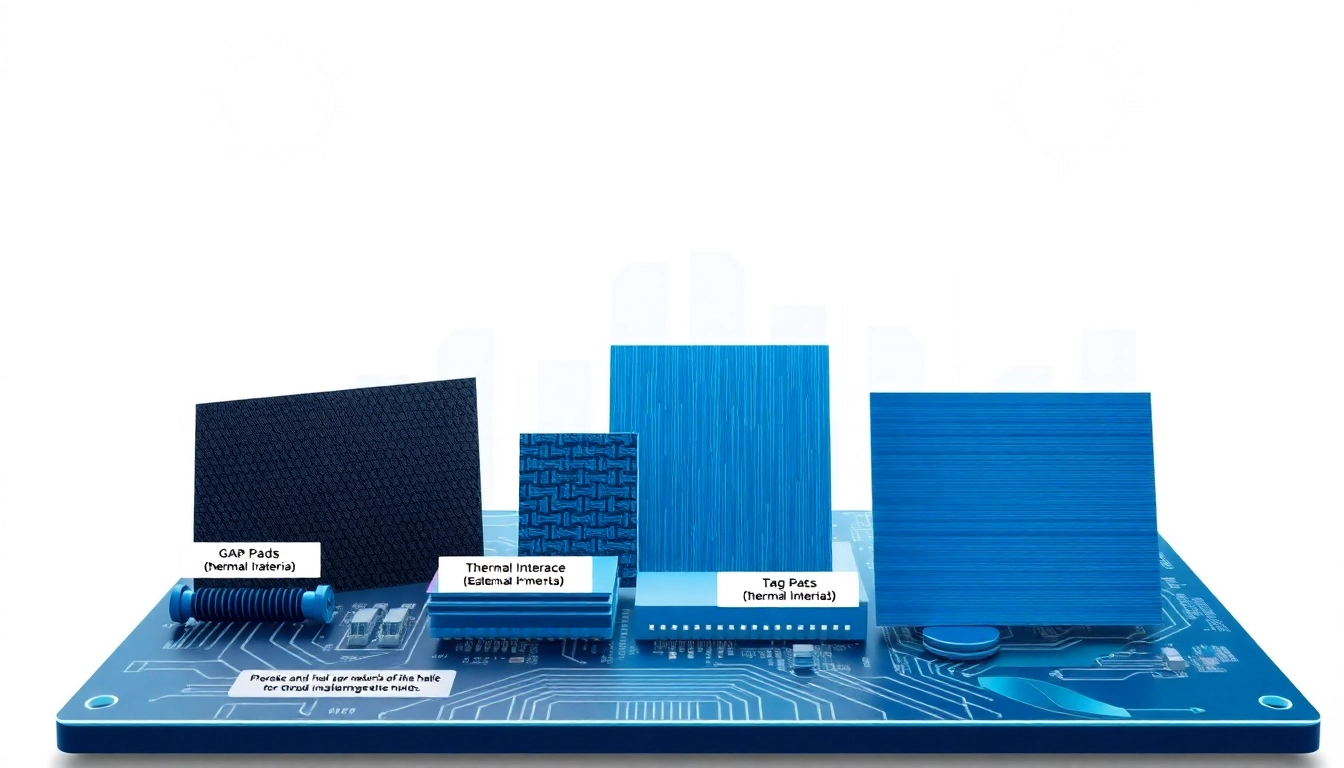Understanding Thermal Management Materials
Thermal management materials play a crucial role in modern electronics by effectively dissipating heat and maintaining optimal operating temperatures. As electronic devices become more complex and compact, the need for efficient thermal management has intensified. These materials help in preventing overheating, which can lead to decreased performance, reduced lifespan, and even failure of electronic components. In this comprehensive guide, we will delve into the definition and importance of thermal management materials, explore different types available, their applications across various industries, and provide insights on best practices for implementation. For a deeper insight, you can also explore thermal management materials offered by various manufacturers.
Definition and Importance
Thermal management materials are specially designed substances that help regulate temperature within electronic systems and devices. They assist in transferring heat away from heat-generating components, ensuring that devices function within their design limits. Effective thermal management is critical not just for operational efficiency, but also for safety and reliability. Overheating can cause thermal runaway in batteries, deterioration of materials, and even catastrophic system failures.
Types of Thermal Management Materials
There is a variety of thermal management materials available, each tailored to address specific thermal conduction, insulation, or dissipation needs. Commonly used types include:
- Thermal Interface Materials (TIMs): These materials fill the gaps between heat-generating components and heat sinks to enhance thermal conductivity.
- Thermal Gap Pads: Soft, compressible pads that provide excellent heat transfer and serve as an insulator.
- Thermal Adhesives: Adhesives that not only bond but also conduct heat, ensuring a solid thermal pathway.
- Thermal Gels: Gel-like substances that fill spaces between components and have high thermal conductivity.
- Phase Change Materials (PCMs): These materials absorb and release heat during phase transitions, maintaining temperature stability.
Applications in Electronics and Beyond
Thermal management materials are widely utilized not just within electronic devices but also in automotive, aerospace, consumer electronics, LED lighting, and medical equipment. For instance, in electric vehicles, thermal management is paramount for optimizing battery life and performance, whereas in consumer electronics, materials like thermal pads and TIMs ensure that high-performance CPUs and GPUs operate efficiently without overheating.
Categories of Thermal Management Materials
Thermal Interface Materials (TIMs)
Thermal Interface Materials (TIMs) are critical in facilitating heat transfer between surfaces in various electronic assemblies. They are designed to fill air gaps and surface imperfections, reducing thermal resistance. Common TIMs include thermal pastes, pads, and films. These materials can significantly enhance the thermal conductivity in applications ranging from computer CPUs to power amplifiers.
Thermal Gap Pads and Adhesives
Thermal gap pads are often used in applications where traditional screws and mounting techniques are impractical. They provide cushioning and conformability while maintaining excellent thermal transfer properties. In contrast, thermal adhesives bond components while conducting heat, allowing innovative designs with fewer mechanical fasteners. These products are ideal for filling larger gaps that require effective thermal management without compromising mechanical stability.
Comparative Analysis of Materials
Choosing the right thermal management material largely depends on application requirements, including thermal conductivity, mechanical properties, and environmental factors. Thermal gap pads are more adaptable and easier to apply than traditional mechanically fastened options, whereas TIMs, such as thermal paste, are preferred for applications that allow for tight assembly tolerances. In contrast, thermally conductive adhesives combine adhesion with thermal management, often chosen for applications that demand strong, reliable bonding alongside heat dissipation.
Key Benefits of Using Thermal Management Materials
Improving Heat Dissipation
The primary benefit of thermal management materials is their ability to enhance heat dissipation. Efficient transfer of heat prevents overheating and ensures components operate within safe temperature ranges, which is essential for performance and device longevity.
Enhancing Product Longevity
By maintaining optimal thermal conditions, thermal management materials can significantly enhance the longevity of electronic devices. Reduced thermal stress means less wear on components, which ultimately leads to fewer failures and extended lifecycles—particularly crucial in mission-critical applications.
Maximizing Energy Efficiency
Efficient thermal management reduces the energy required for cooling systems, hence maximizing overall energy efficiency. In applications such as data centers where large amounts of heat are generated, effective thermal management materials can lead to substantial cost savings in energy consumption and operational expenses.
Best Practices for Implementing Thermal Management Solutions
Choosing the Right Material for Your Needs
When selecting thermal management materials, consider factors such as thermal conductivity, application environment, thickness, and mechanical properties. Evaluating the specific requirements of each application is fundamental to making an informed choice. Collaborating with vendors who specialize in thermal management can offer additional insights into the best materials suitable for various conditions and requirements.
Installation Techniques and Considerations
Proper installation of thermal management materials is critical for ensuring optimal performance. Common techniques include surface preparation, ensuring proper alignment, and applying even pressure during installation. It is also essential to follow manufacturer guidelines regarding application thickness and curing times to avoid performance issues.
Cost-Effectiveness and Performance Metrics
Evaluating the cost-effectiveness of thermal management materials involves analyzing both direct costs and potential savings from improved efficiency and longevity. Performance metrics should include thermal resistance values, energy consumption data, and reliability under varied environmental conditions. Investing in higher-quality materials may yield better long-term results, reducing maintenance and failure costs.
Future Trends in Thermal Management Technologies
Innovations in Material Science
Advancements in material science continue to drive the evolution of thermal management solutions. Research is focused on developing new materials with improved thermal conductivity while also being lightweight and environmentally friendly. Innovations such as nanomaterials and advanced composites are set to redefine the thermal management landscape.
Sustainability in Thermal Management Solutions
As industries increasingly focus on sustainability, manufacturers of thermal management materials are seeking eco-friendly alternatives. This includes the development of recyclable materials and processes that minimize environmental impact without compromising performance. Sustainable practices are not only better for the environment, but they can also enhance brand loyalty among eco-conscious consumers.
Predictions for Market Growth
The global market for thermal management materials is expected to experience significant growth over the coming years. This growth is driven by the increasing demand for efficient thermal solutions in various applications, particularly in sectors such as electric vehicles and consumer electronics. A recent report indicates that the market is projected to reach unprecedented levels by 2032, fueling further innovation in the field.



